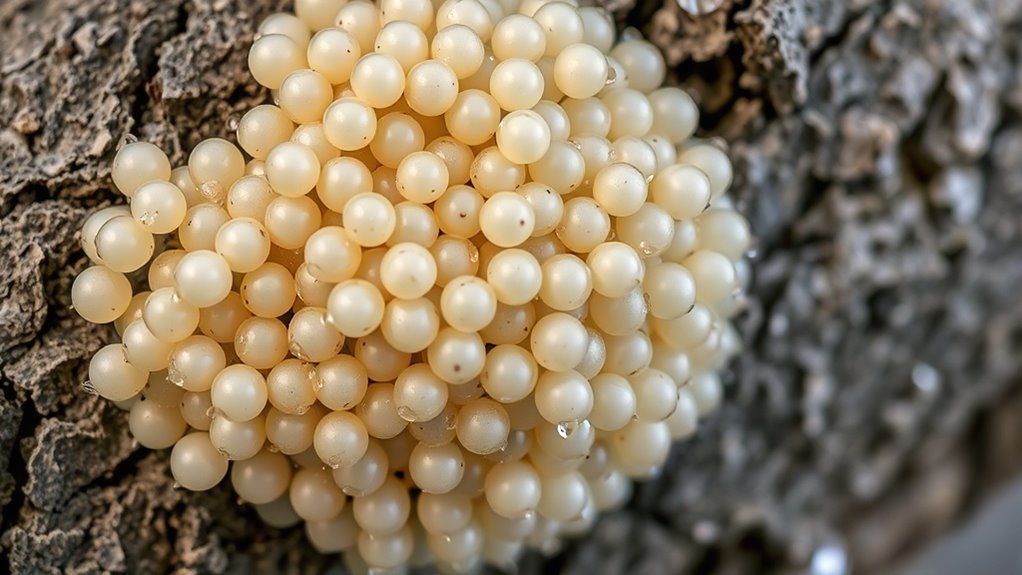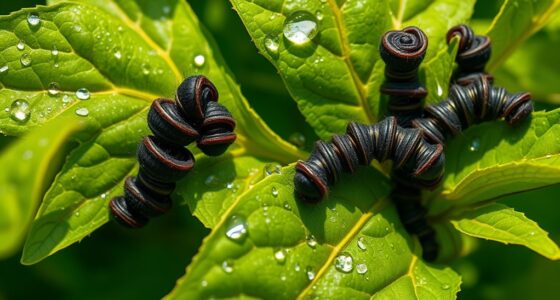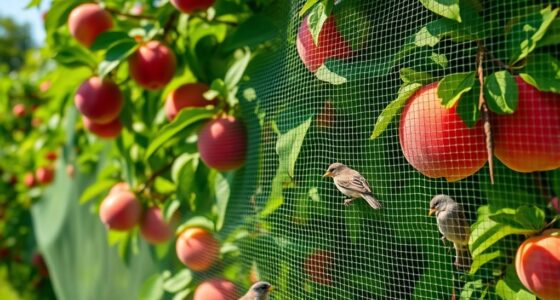To spot overwintering egg masses, look for compact clusters attached to the undersides of leaves, stems, or bark on host plants like hawthorn, cherry, or apple. They often appear as flattened groups in colors like white, cream, gray, or tan, sometimes with a waxy coating. Pay attention to specific patterns or shapes characteristic of certain species. Recognizing these signs early can help you manage pests effectively; keep going to learn more.
Key Takeaways
- Focus on host plants like hawthorn, cherry, or apple, where specific insects lay their overwintering eggs.
- Look for compact, flattened egg clusters attached to the underside of leaves, stems, or bark.
- Identify eggs by their color (white, cream, gray, or tan) and possible waxy coating or protective casing.
- Check for characteristic patterns or arrangements, such as rows or specific shapes unique to certain species.
- Detect signs during late fall or early winter, noting tightly glued eggs on plant surfaces, indicating overwintering sites.

When searching for overwintering egg masses, the first step is to focus on host plant selection. Different insects prefer particular plants to lay their eggs, often choosing those that provide the best shelter or food source once the eggs hatch. For instance, many caterpillars favor hawthorn, cherry, or apple trees, while others might choose shrubs like viburnum or dogwood. By knowing which plants are their preferred hosts, you can narrow your search and identify potential overwintering sites more efficiently. These host plants often serve as the first line of defense in monitoring pest populations, especially when you’re trying to prevent damage early in the season. Awareness of common pitfalls in plant identification can help prevent misidentification of host plants, ensuring more accurate monitoring.
Once you’ve identified potential host plants, the next step is to look for egg mass identification. Egg masses vary in appearance depending on the species, but generally, they are compact clusters attached to the underside of leaves, stems, or bark. They often have a distinctive color—ranging from white or cream to gray or tan—and may appear as a waxy coating, a cluster of tiny eggs, or a protective casing. Some egg masses are laid in a pattern or shape characteristic of their species, making identification easier if you’re familiar with the specifics. For example, certain moths and butterflies lay eggs in tightly packed, flattened groups, while some beetles deposit individual eggs in a series of rows.
Pay close attention to how these egg masses are attached to the plant. They are usually glued on tightly, making them difficult to remove without damaging the plant tissue. The presence of egg masses during late fall or early winter signals that the insects have successfully overwintered in a protected state, ready to hatch as temperatures warm. Recognizing these signs early can be *vital* for managing pest populations before they emerge and cause damage.
Frequently Asked Questions
When Is the Best Time to Start Searching for Overwintering Egg Masses?
You should start searching for overwintering egg masses in early spring, just as temperatures begin to rise. Timing considerations are vital because seasonal variations influence when these egg masses become visible. Keep an eye on host plants and sheltered areas where insects tend to lay eggs. By monitoring these sites during early spring, you increase your chances of spotting overwintering eggs before they hatch and spread.
Which Plants Are Most Likely to Host Overwintering Egg Masses?
You’ll want to keep an eye out for egg masses on plants like maples, lilacs, and fruit trees, as they’re prime hosts. When doing host plant identification, focus on smooth, flat surfaces where egg masses often appear. Egg mass differentiation is key—look for gray, cottony layers or clusters. Early detection is vital; don’t miss the boat, so check these plants regularly in late fall and early spring.
How Can I Distinguish Egg Masses From Other Plant Debris?
To distinguish egg masses from plant debris through visual identification, look closely at their shape, color, and texture. Egg masses are often oval or rounded, sometimes with a frosty or waxy coating, and tend to be attached firmly to stems or leaves. Unlike loose plant debris, they won’t crumble easily and are usually concentrated in specific areas, making plant debris differentiation clear with careful inspection.
Are There Any Natural Predators That Target Overwintering Egg Masses?
Did you know that natural predator interactions can markedly reduce pest populations? Certain birds, beetles, and parasitic wasps target overwintering egg masses, offering natural biological control methods. These predators help keep pest numbers in check without chemicals. By encouraging these beneficial insects and birds in your garden, you support a balanced ecosystem that naturally suppresses pests, making your garden healthier and more resilient year-round.
What Tools or Equipment Help in Locating Hidden Egg Masses?
You can use thermal imaging to detect hidden egg masses, especially in shaded or hard-to-see areas, as it reveals temperature differences. Hand lenses are also helpful, allowing you to closely examine leaves, bark, and soil where eggs might be concealed. Combining these tools increases your chances of locating overwintering egg masses early, so you can manage pests effectively and protect your plants before they hatch.
Conclusion
Keep an eye out for overwintering egg masses, as they’re like tiny treasure chests waiting to hatch new life. Spotting these eggs early helps you understand the lifecycle and manage pests effectively. Just as a gardener tends carefully to their plants, you can nurture a healthier environment by observing these hidden stages. Staying vigilant now ensures a thriving garden in the seasons to come, turning nature’s quiet preparations into a beautiful, lively spring.









